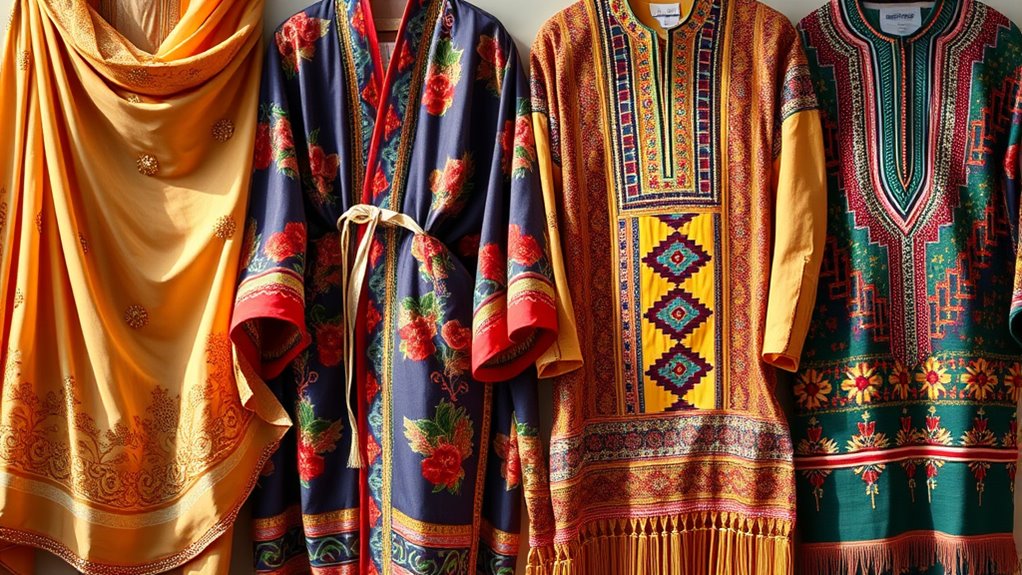Different cultures markedly influence modern fashion through vibrant textiles, traditional techniques, and unique motifs. Asian silks and patterns bring elegance and symbolism, while African textiles with bold colors and lively designs add energy and cultural meaning. Middle Eastern embroidery and Latin American weaving enrich styles with intricate details and vibrant hues. Indigenous symbols and cross-cultural blends create diverse looks that honor heritage and inspire innovation—if you want to explore how these cultural elements continue shaping your wardrobe, keep exploring further.
Key Takeaways
- Traditional textiles and motifs from Asia and Africa shape contemporary fashion with vibrant patterns and symbolic designs.
- Cultural techniques like dyeing and embroidery add authenticity and depth to modern clothing and runway collections.
- Fusion of cultural elements in streetwear and high fashion promotes global style diversity and storytelling.
- Designers incorporate heritage patterns and craftsmanship to emphasize cultural preservation and sustainable practices.
- Cross-cultural collaborations inspire innovative trends that celebrate cultural diversity and innovation in fashion.
The Impact of Asian Silks and Patterns in Contemporary Fashion
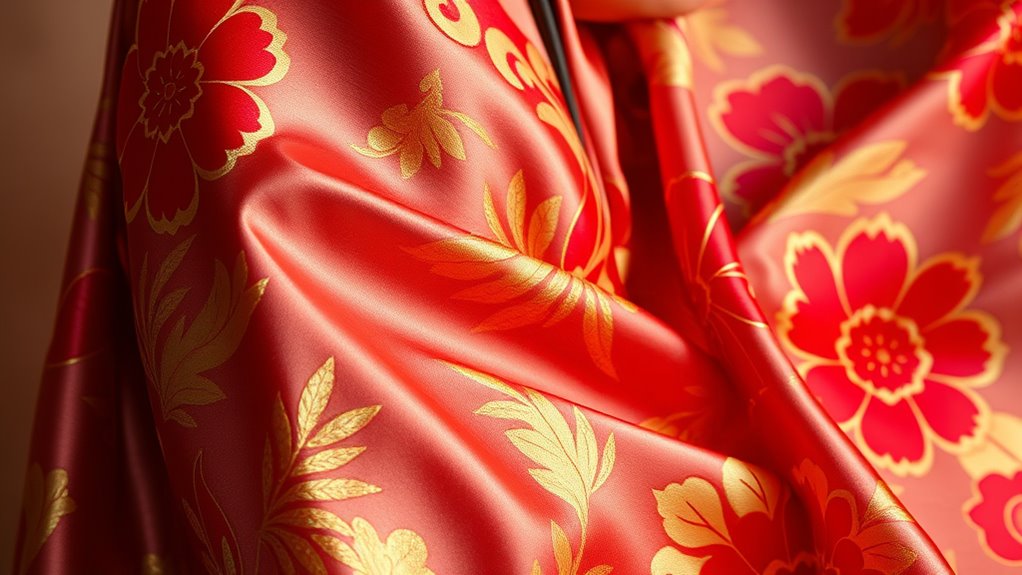
Asian silks and intricate patterns have profoundly shaped contemporary fashion, blending tradition with modern design. You’ll notice how textile dyeing techniques, like vibrant indigos and rich golds, bring these fabrics to life, creating eye-catching pieces. Pattern symbolism plays an essential role, with motifs such as dragons, florals, and phoenixes representing power, beauty, and renewal. These symbols aren’t just decorative; they carry cultural meanings that add depth to fashion designs. Designers incorporate these traditional elements to evoke a sense of history and craftsmanship, infusing modern clothing with cultural significance. Additionally, understanding the cultural symbolism behind these patterns enhances appreciation for their significance in fashion. Recognizing the artistic techniques used in creating these textiles highlights the skill and tradition passed down through generations. The dying techniques employed in Asian textiles, such as resist dyeing and hand-painting, showcase the meticulous craftsmanship involved. As a result, Asian-inspired textiles create a unique fusion, making contemporary fashion both stylish and meaningful. This blend of dyeing techniques and symbolic patterns continues to influence global trends, highlighting the enduring impact of Asian textiles.
African Textiles and Their Bold Influence on Global Style

African textiles are known for their vibrant patterns and bold colors that command attention. These fabrics often carry deep cultural meanings, representing identity, history, and social status. Today, you’ll see their influence shaping global fashion, inspiring designers to incorporate these striking elements into mainstream styles. The popularity of these textiles also reflects a broader trend of cultural exchange driven by increased global connectivity. Developing a cultural intelligence helps designers and consumers appreciate and respect the significance of these textiles across different cultures.
Vibrant Patterns and Colors
Vibrant patterns and bold colors are at the heart of African textiles, mesmerizing global fashion with their striking designs. These textiles showcase expert textile dyeing techniques, creating vivid, complex patterns that stand out. Throughout fashion history, African fabrics have influenced designers worldwide, inspiring everything from high-end runway collections to streetwear. The use of natural dyes and intricate weaving methods gives these textiles their unique appeal, emphasizing cultural identity and craftsmanship. When you see bright kente cloth or Ankara prints, you’re witnessing how African textile art transforms fashion, adding energy and vibrancy. The cultural significance of these textiles further enhances their value, making them a source of inspiration for innovative and authentic designs. This influence continues to grow as designers seek authentic, bold statements that celebrate heritage and innovation, making these textiles a powerful force shaping modern aesthetics across the globe. Additionally, the techniques used in creating these textiles demonstrate a high level of skill and tradition that has been passed down through generations, enriching their cultural importance.
Cultural Significance of Textiles
Textiles carry deep cultural meaning, serving as powerful symbols of identity, history, and social status. African textiles, like kente and mudcloth, exemplify this significance through their intricate textile craftsmanship and vibrant designs. These textiles often reflect community values, ancestral stories, and spiritual beliefs. As global interest grows, there’s a rising focus on textile sustainability, encouraging the preservation of traditional methods and eco-friendly practices. By valuing textile craftsmanship, you honor centuries-old techniques that produce authentic, meaningful fabrics. African textiles influence worldwide fashion not just through their bold patterns but also by highlighting cultural stories and sustainable practices. Their enduring appeal reminds you that clothing can be more than mere fabric—it’s a connection to heritage and a statement of respect for craftsmanship. Additionally, understanding the workaholic relationship struggles behind some fashion industries can promote more mindful consumption and appreciation for handcrafted textiles. Recognizing the importance of sustainable materials helps ensure these traditional techniques are preserved for future generations, fostering a circular economy that benefits artisans and the environment alike.
Global Fashion Incorporation
Because of their bold patterns and rich cultural stories, African textiles have become a powerful influence on global fashion. Designers worldwide now incorporate these fabrics, emphasizing sustainable sourcing to preserve traditional craftsmanship and support local communities. Fashion technology plays a vital role in this movement, enabling brands to replicate intricate designs with eco-friendly methods that reduce waste. This integration ensures that African textiles remain authentic while meeting modern sustainability standards. As a result, you see vibrant, culturally rich patterns in everything from high-end runways to streetwear. By blending traditional techniques with cutting-edge fashion technology, the global fashion industry celebrates African textiles’ bold influence, making cultural expression not just a statement but a sustainable practice that respects heritage and innovation alike. Additionally, Camper conversions highlight the importance of craftsmanship and customization, echoing how traditional skills are adapted for modern applications. Incorporating textile innovation has further enhanced the ability to preserve intricate patterns while reducing environmental impact, demonstrating how sustainable practices are transforming the industry.
Middle Eastern Embroidery and Ornamental Detailing
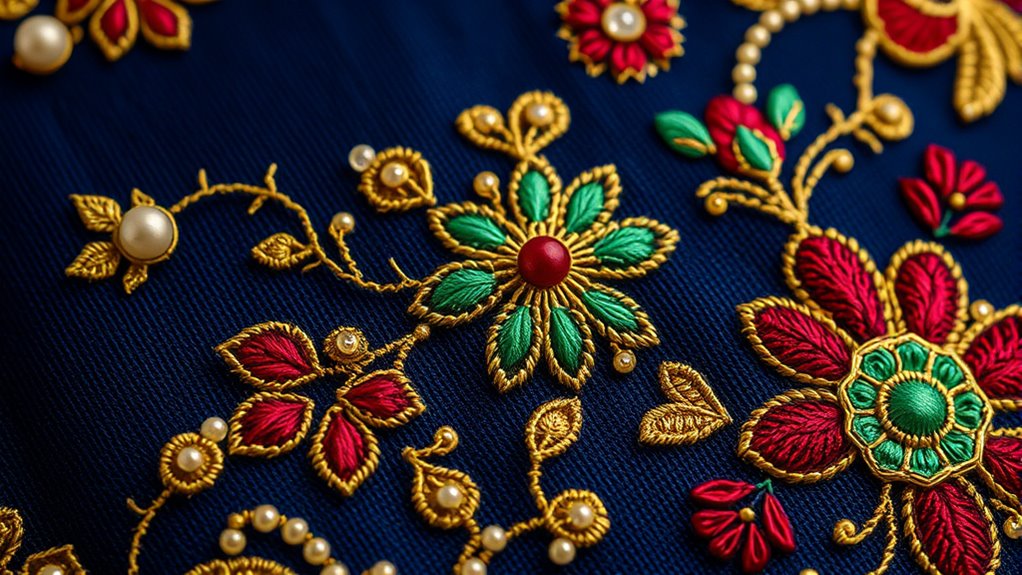
Middle Eastern embroidery and ornamental detailing are celebrated for their intricate patterns and rich symbolism, which often reflect cultural identity and historical traditions. You’ll notice calligraphic motifs woven into textiles, showcasing beautiful Arabic script that adds spiritual significance. Gemstone embellishments are also common, elevating garments with shimmering accents that symbolize wealth and protection. These details serve a dual purpose: they demonstrate craftsmanship and convey meaningful stories or beliefs. The embroidery’s complexity reveals skilled artisanship, often passed down through generations. Whether on traditional robes, wedding attire, or modern fashion pieces, Middle Eastern ornamental details create a sense of elegance and heritage. The use of traditional techniques highlights the enduring craftsmanship that connects past and present. Incorporating these elaborate designs can also enhance the visual appeal of contemporary fashion, blending tradition with modern aesthetics. The meticulous craftsmanship involved also emphasizes the importance of cultural preservation in maintaining these artistic techniques. When you incorporate these elements into your wardrobe, you honor a centuries-old tradition of artistry and cultural expression that continues to influence contemporary style globally.
Latin American Colors and Weaving Techniques in Modern Apparel
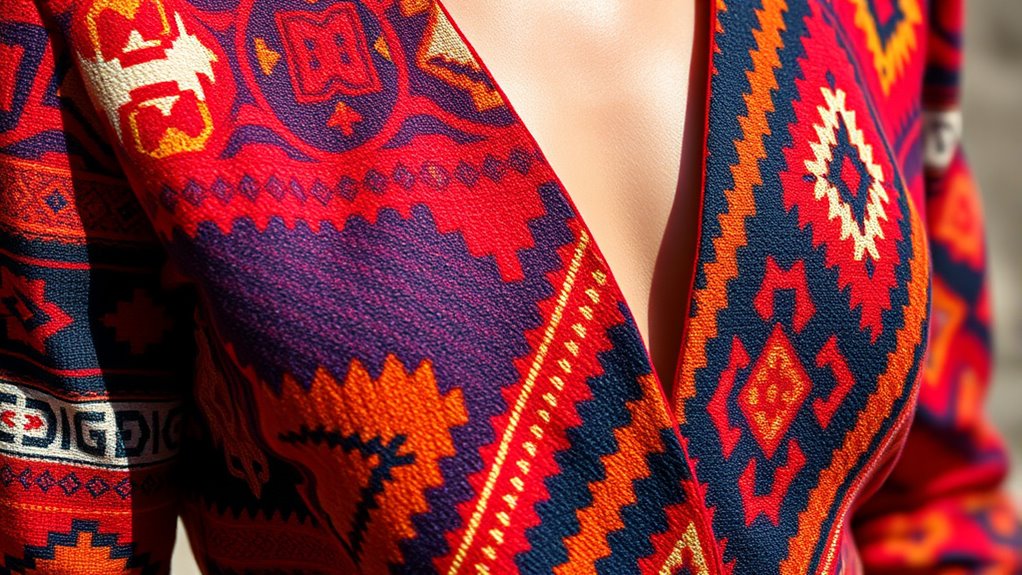
Latin American textiles burst with vibrant colors and dynamic weaving techniques that bring cultural stories to life. You can see how traditional craftsmanship plays an essential role in preserving these skills, passed down through generations. Modern designers incorporate these techniques into apparel, blending cultural authenticity with contemporary fashion. They prioritize sustainable sourcing, ensuring that fibers and materials are ethically obtained, supporting local communities and reducing environmental impact. Bright hues like turquoise, red, and yellow reflect regional landscapes and traditions, making each piece uniquely expressive. By embracing these vibrant colors and weaving methods, you help promote cultural heritage and sustainable practices. Additionally, understanding the vibrational energy behind these cultural expressions can deepen appreciation and connection to the artistry. Recognizing the genetic variation responsible for unique coat colors helps appreciate the diversity within dog breeds, inspiring designers to celebrate natural differences in their collections. This fusion of tradition and innovation creates bold, meaningful fashion that connects you to Latin America’s rich artistic legacy.
Indigenous Motifs and Cultural Symbols in Fashion Design
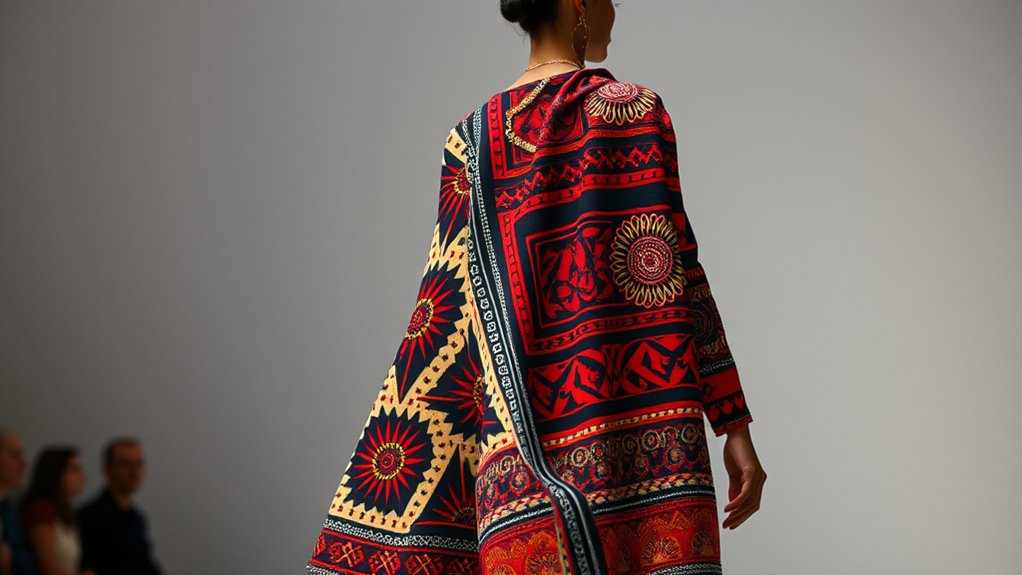
Indigenous motifs and cultural symbols serve as powerful expressions of identity and history in fashion design. You notice how designers incorporate symbolic embroidery that reflects specific traditions, stories, and spiritual beliefs. These intricate patterns often carry deep meaning, connecting wearers to their heritage. Indigenous jewelry also plays a crucial role, with pieces crafted from locally sourced materials that symbolize social status, protection, or spiritual beliefs. When these elements are integrated into modern fashion, they honor and preserve cultural identities while creating striking visuals. By blending traditional motifs with contemporary styles, designers foster awareness and appreciation for indigenous cultures. Additionally, incorporating cultural symbols into mainstream fashion helps promote cross-cultural understanding and respect. Recognizing the importance of asset division laws in protecting cultural property helps ensure that indigenous motifs are used ethically and with proper acknowledgment. Moreover, understanding the Hopi Tribe’s role as guardians of sacred lands emphasizes the importance of respecting cultural boundaries and origins in fashion collaborations.
The Fusion of Western and Non-Western Fashion Elements

You’ll notice how designers blend textures creatively, combining fabrics from different cultures to create fresh looks. Cultural symbols often find new life in fashion, adding meaning and depth to hybrid styles. On runways worldwide, you see this fusion through bold, innovative designs that celebrate diversity and innovation.
Blending Textures Creatively
When blending textures in fashion, designers often combine Western fabrics like denim or leather with non-Western materials such as silk, batik, or woven fibers to create striking visual contrasts. This approach emphasizes textural contrast and enhances material layering, making each piece stand out. To achieve this, they might:
- Pair rugged denim with delicate silk panels
- Layer leather patches over traditional woven fabrics
- Mix stiff batik with soft, flowing textiles
- Combine textured embroidery with smooth fabrics
- Use contrasting textures to highlight cultural motifs
- Incorporate textile preservation techniques to ensure traditional fabrics maintain their integrity during mixing. Additionally, understanding the financial impact of cultural fashion trends can guide designers in making sustainable and culturally respectful choices. Employing mindfulness in design processes can foster greater cultural sensitivity and innovation throughout the creative journey.
Cultural Symbols in Style
Cultural symbols play a powerful role in shaping fashion by blending Western and non-Western elements to create meaningful, visually striking designs. When used thoughtfully, these symbols can celebrate cultural heritage and promote understanding through fashion activism. However, you must be cautious of cultural appropriation, which occurs when designers adopt symbols without respecting their significance or context. Such actions can offend communities and undermine genuine appreciation. Instead, focus on respectful collaborations and authentic storytelling that honor origins. By consciously integrating cultural symbols, you help foster appreciation and dialogue rather than controversy. Your awareness of these dynamics ensures that the fusion of styles enriches fashion, making it a tool for cultural exchange rather than appropriation or misrepresentation.
Hybrid Fashion Runways
Hybrid fashion runways showcase the dynamic blending of Western and non-Western elements, transforming traditional styles into innovative and globally appealing designs. You’ll see designers combine cultural motifs with modern silhouettes, creating fresh aesthetics that resonate worldwide. This trend emphasizes sustainability by using sustainable textiles and futuristic materials, pushing fashion toward eco-friendly innovations.
- Incorporate traditional embroidery with tech-inspired fabrics
- Use sustainable textiles for eco-conscious designs
- Fuse Western tailoring with non-Western patterns
- Experiment with futuristic materials like bio-fabrics
- Highlight cultural symbols in modern runway presentations
Traditional Attire Inspiring Modern Streetwear and Runway Looks
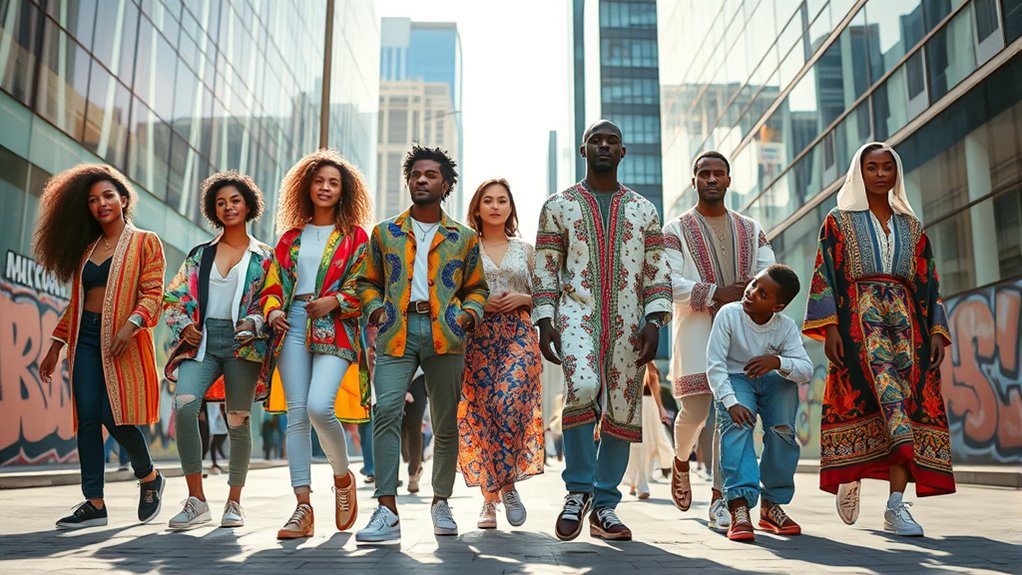
Traditional attire has become a rich source of inspiration for modern streetwear and runway designs, blending cultural heritage with contemporary fashion. Designers often incorporate authentic textiles, emphasizing textile preservation to honor cultural craftsmanship. This approach not only celebrates diverse traditions but also promotes fashion sustainability by reducing waste and encouraging the reuse of traditional fabrics. You’ll notice how elements like embroidered patterns, vibrant colors, and unique textiles are seamlessly integrated into modern looks, creating a fusion of old and new. This trend supports ethical fashion practices by valuing handmade techniques and supporting local artisans. By drawing from traditional attire, your wardrobe and runway collections become more meaningful, fostering a deeper connection to cultural roots while championing sustainability in an ever-evolving fashion landscape.
The Role of Cultural Preservation in Fashion Innovation
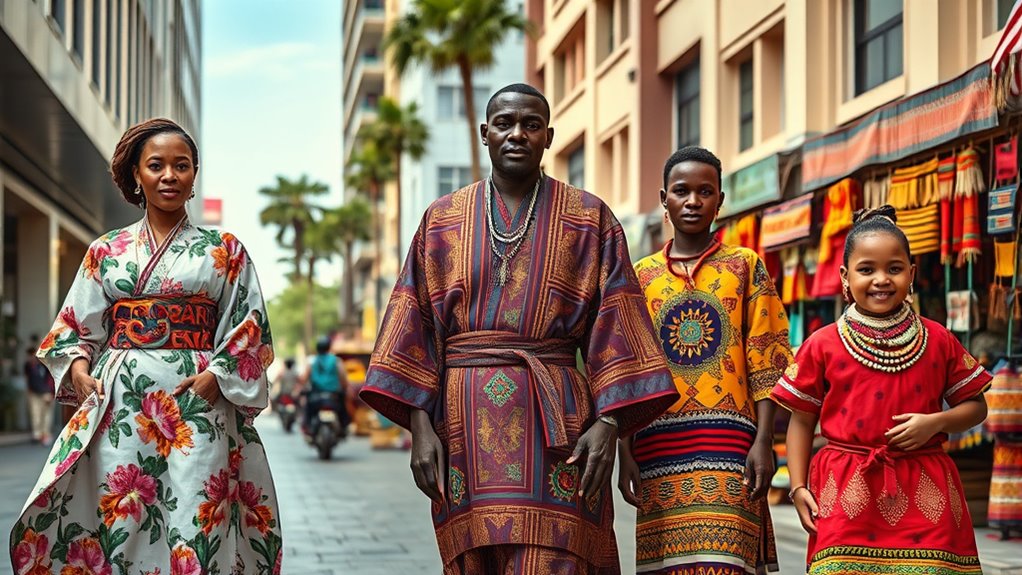
Preserving cultural heritage plays a critical role in driving innovation within the fashion industry. When you honor cultural identity, you create a foundation for authentic designs that resonate deeply. This preservation fosters fashion authenticity, ensuring that modern trends respect and reflect traditional values. By integrating heritage textiles, patterns, and techniques, designers push creative boundaries while maintaining cultural significance.
- Reinforces unique cultural narratives
- Inspires sustainable and ethical practices
- Encourages cross-cultural collaborations
- Promotes awareness of cultural diversity
- Keeps traditional craftsmanship alive
Through these efforts, fashion evolves without losing its roots. You become part of a movement that values authenticity and celebrates cultural richness. This balance between innovation and preservation ensures that fashion remains meaningful, diverse, and true to its origins.
Frequently Asked Questions
How Do Cultural Sensitivities Influence the Global Adoption of Traditional Fashion Elements?
Cultural sensitivities shape how you adopt traditional fashion elements globally. You need to differentiate between cultural appreciation and cultural appropriation; respecting origins fosters positive exchanges, while appropriation can cause offense. When you honor traditions thoughtfully, you promote understanding and appreciation, encouraging diverse styles to thrive. Being aware of sensitivities helps you avoid missteps and supports a respectful, inclusive fashion landscape that celebrates cultural identity without exploitation.
What Challenges Arise When Integrating Indigenous Symbols Into Mainstream Fashion?
When you integrate indigenous symbols into mainstream fashion, you face challenges like cultural appropriation and symbolic misrepresentation. People may see this as disrespectful or trivializing meaningful cultural elements, leading to backlash. You need to be sensitive and informed, respecting the origins and significance of symbols. Avoid using symbols superficially or out of context, and consider collaborating with or seeking permission from the culture’s community to guarantee respectful representation.
How Do Fashion Designers Ensure Authentic Representation of Cultural Motifs?
Think of cultural motifs as delicate threads in a tapestry—each one telling a unique story. To guarantee authentic representation, you should engage in cultural consultation, listening directly to community voices. Additionally, using motif licensing helps protect original designs. This respectful approach preserves their meaning and prevents misappropriation, turning your fashion creations into genuine celebrations of cultural diversity rather than superficial trends.
In What Ways Does Globalization Impact the Preservation of Traditional Dress?
Globalization impacts traditional dress by increasing cultural commodification, making unique styles more accessible but also risking their dilution. You might notice traditional garments becoming trendy worldwide, which can threaten cultural preservation. While globalization promotes appreciation, it’s essential to respect origins and avoid commodifying cultural symbols. By supporting authentic artisans and learning about the history behind traditional dress, you help preserve cultural identity amidst global influences.
Can Traditional Attire Be Adapted for Sustainability and Ethical Fashion Practices?
Imagine transforming a centuries-old kimono into a sustainable masterpiece—that’s cultural adaptation at its finest. You can reimagine traditional attire by using eco-friendly fabrics and ethical sourcing, blending history with modern values. This way, you honor cultural roots while championing sustainability. By consciously choosing ethical materials and respecting cultural significance, you turn traditional dress into a powerful symbol of eco-conscious fashion that respects both heritage and the planet.
Conclusion
As you explore the world’s vibrant wardrobe, you see how cultures weave their stories into fashion’s fabric. Each pattern, color, and stitch becomes a thread connecting tradition to trend, creating a tapestry richer than you imagined. Embrace these styles as your own, and watch how they transform your perspective—like a kaleidoscope turning with every new influence. In this global runway, you’re not just a spectator; you’re part of the beautiful, ongoing story of fashion.
